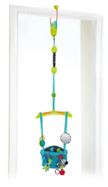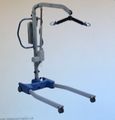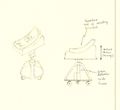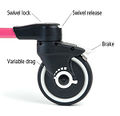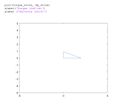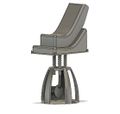Therapeutic stroller/swing
Abstract
A sixteen month old baby suffers from a undiagnosed disease that causes her to acquire a quick fatigue when using her johnny jumper.
Team Photo
- Team members
-Jonas Cunningham-Rush -Robert Shelton -Colby Jamerson -Josef Bangean -Hyung guen Cho
Problem Statement/overview of the need
We are designing an indoor bouncing chair for a baby girl with cerebral palsy. The chair will need to bounce up and down by itself, and keep her maintained in the right positions so that she doesn't have to hold herself up, or fall out. The chair will be made to perfectly fit the widely used tumbleform therapeutic seat that already satisfies the family's and Scout's needs.
Design Specifications
1. The chair must be optimized for safety, comfort, and mobiliby while maintaining a small footprint.
2. The chair must have head/neck support.
3. The seat must bounce automatically.
4. The chair must include a 5-point harness.
5. The seat must be easily removable.
6. The chair should have a small range of speed settings.
Background research
1. Already existing are 2 products that stood out to us. "The Johnny Jumper" and the "Bright Starts Spring and Bounce Deluxe Door Jumper." They each are indoor swings that can be fitted to a door frame and allow a baby to bounce up and down on their own or when pushed by an adult.
2. While these products are readily available, they don't meet our needs fully.
3. Neither of the aforementioned products have neck support, which is something we need. They also don't use a 5-point harness, which was stressed by our family. We also need to have a motorized bouncing mechanism that allows for safe use of a tumbleform seat. For all these reasons, we cannot use the Johnny Jumper or Bright Starts swings.
Conceptual Design
Summarize your conceptual design process. Develop at least three concepts.
Design Concept 1
- Description - This design will utilize a linear motor to achieve vertical motion.
- estimates on performance/simple calculations if needed
Design Concept 2
- Description - This design uses the same linear actuator from the first design but it is connected to a base that is mobile. This design uses a different seat that will not be able to be put into a stroller.
- estimates on performance/simple calculations if needed
Design Concept 3
- Description - This is the only design that uses a chair that is fixed to a base. The base can roll on the ground so that the user can position it where he/she wants. There is a linear actuator that will rock the chair to let Scout swing, and the seat is a Tumbleform, which has a 5 point harness and is already something that Scout is familiar with.
Evaluate concepts/select candidate
| Design # | Safety | Adjustability | Manufacturability | Cost | Total |
|---|---|---|---|---|---|
| 1 | 2 | 2 | 1 | 2 | 7 |
| 2 | 3 | 2 | 2 | 1 | 8 |
| 3 | 3 | 3 | 3 | 2 | 11 |
We decided to move ahead with design 3. Design 3 was the safest design, and the easiest and quickest to design and build. We will use a linear actuator to move the chair up down to swing baby Scout. She is already familiar with the chair, which her mom sometimes puts Scout in when she is too busy to hold her.
Detailed Design
- Numbered list item
Description of selected design
We are going with design 3
Detailed description of selected design
We will be using a Node Chair from SteelCase to use as a base for our swing. The Tumble Form chair will be seated on top of the base, connected by a metal bracket. A linear actuator will connect the bottom of the base to the bottom of the chair and move it up and down because Scout likes to be moving all the time. The position of the chair will be adjustable thanks to the velcro on the Tumble Form.
Analysis
Describe three types of analysis to be performed on the design
Engineering analysis 1
Torque Analysis This analysis shows the amount of torque required by the motor to power the seat throughout each cycle. The motion of the mechanism was modeled in MATLAB, and this graph shows torque vs. radial displacement. The peak torque required is about 152 lb*in
Engineering analysis 2
Velocity and Torque Analysis This analysis also stems from our mechanism model in matlab. It graphs Shaft Velocity vs. Required torque on the motor. It shows the required torque with respect to velocity. It represents the relationship between our decided velocity of the shaft and the required torque on the motor; if we changed the velocity of the chair, the required torque would change as well
Engineering analysis 3
This is our last needed analysis, which involved a double shear on the steel pin for our crank mechanism. Almost all of the weight is on this pin at times, therefore we wanted to make sure our design was safe.
CAD Drawings
Insert drawings of all parts and the assembly
Bill of Materials
qty, item, description, source, part number, price
Bills Of Materials 001.PNG
Assembly Instructions
Fabrication Process
Testing and implementation
Describe testing, delivery, how used/received by the family
Photos of Completed design
Insert pictures of the final product
Instructions for safe use
Provide a clear summary of safe use for the family. Do not use the device unless supervised by an adult that has been fully understood the safe use of this product.

